 |
Kage Studio 0.7.240121
A Simple Free and Open Source 2D Animation Software
|
 |
Kage Studio 0.7.240121
A Simple Free and Open Source 2D Animation Software
|
#include <layer.h>
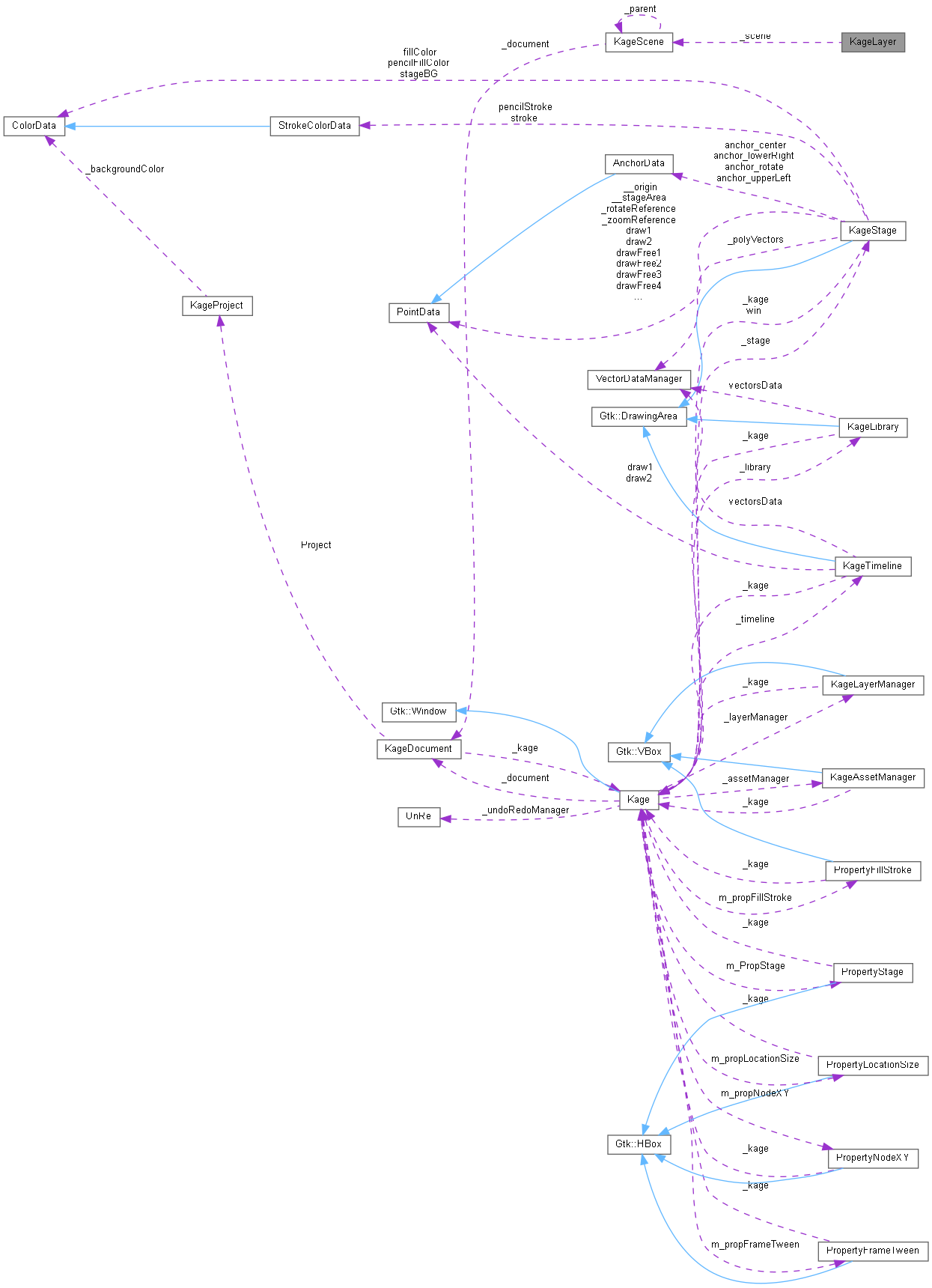
Public Member Functions | |
| KageLayer (KageScene *p_scene, unsigned int p_layerID, unsigned int p_frameCount) | |
| KageLayer | operator= (const KageLayer &p_layer) |
| virtual | ~KageLayer () |
| unsigned int | getID () |
| bool | selectAllFrame (bool p_selectAll) |
| bool | addFrame () |
| void | duplicateFrame () |
| void | extendFrame () |
| bool | removeFrame () |
| unsigned int | getCurrentFrame () |
| void | setCurrentFrame (unsigned int p_frame, bool p_addSelected) |
| void | setCurrentFrameByID (unsigned int p_frameID) |
| bool | removeAllFrames () |
| KageScene * | getScene () |
| KageFrame * | getFrame () |
| KageFrame * | getFrameAt (unsigned int p_frame) |
| unsigned int | getFrameNumberByID (unsigned int p_frameID) |
| void | setSelected (KageFrame *p_frame) |
| std::vector< unsigned int > | raiseSelectedShape (std::vector< unsigned int > p_selectedShapes) |
| std::vector< unsigned int > | lowerSelectedShape (std::vector< unsigned int > p_selectedShapes) |
| std::vector< unsigned int > | raiseToTopSelectedShape (std::vector< unsigned int > p_selectedShapes) |
| std::vector< unsigned int > | lowerToBottomSelectedShape (std::vector< unsigned int > p_selectedShapes) |
| std::vector< unsigned int > | groupSelectedShapes (std::vector< unsigned int > p_selectedShapes) |
| std::vector< unsigned int > | ungroupSelectedShapes (std::vector< unsigned int > p_selectedShapes) |
| std::vector< unsigned int > | duplicateShapes (std::vector< unsigned int > p_selectedShapes) |
| bool | flipHorizontalSelectedShape (std::vector< unsigned int > p_selectedShapes) |
| bool | flipVerticalSelectedShape (std::vector< unsigned int > p_selectedShapes) |
| bool | doFlipVerticalSelectedShapeOn (unsigned int p_frameIndex, std::vector< unsigned int > p_selectedShapes) |
| bool | doFlipVerticalSelectedShapeOnExtendedFrame (unsigned int p_frameIndex, std::vector< unsigned int > p_selectedShapes) |
| bool | recenterRotationPoint (std::vector< unsigned int > p_selectedShapes) |
| bool | addDataToFrame (VectorDataManager p_vectorsData) |
| bool | setFrameData (VectorDataManager p_vectorsData) |
| VectorDataManager | getFrameTweenData (unsigned int p_frameIndex) |
| VectorDataManager | getFrameData () |
| VectorDataManager | getFrameDataAt (unsigned int p_frame, bool p_frameOnion, bool p_layerOnion) |
| VectorDataManager | getPreviousFrameData (unsigned int p_frameID) |
| NOTE: "Frame" – NOT "frame ID". | |
| bool | setFrameDataToPreviousFrame (VectorDataManager p_vectorsData, unsigned int p_frameID) |
| Called by KageFrame if KageFrame is Extended. | |
| bool | addDataToPreviousFrame (VectorDataManager v, unsigned int p_frameID) |
| Called by KageFrame if KageFrame is Extended. | |
| bool | setPreviousFrameTween (unsigned int p_frameID, unsigned int p_tween) |
| Called by KageFrame if KageFrame is Extended. | |
| bool | setExtendedFrameTween (unsigned int p_frameID, unsigned int p_tween) |
| bool | forceSetTween (unsigned int p_tween) |
| bool | setTween (unsigned int p_tween) |
| unsigned int | getTween () |
| bool | switchToPreviousFrame () |
| bool | switchToPreviousFrame (unsigned int p_frameID) |
| Called by FrameSet for navigating to Previous Frame. | |
| bool | switchToNextFrame () |
| Called by KageFrame for navigating to Previous Frame. | |
| bool | switchToNextFrame (unsigned int p_frameID) |
| Called by FrameSet for navigating to Next Frame. | |
| bool | isCurrentFrame (unsigned int p_frameID) |
| Called by KageFrame for navigating to Next Frame. | |
| bool | canReUseNextFrame () |
| Called by KageFrame when rendering. | |
| void | setFrameExtension (KageFrame::extension p_extension) |
| Called by KageScene when duplicating Frame. | |
| unsigned int | getActiveFrameID () |
| Will return which Frame is currently active for editing or viewing. | |
| bool | moveToLeft () |
| bool | moveToLeftAt (unsigned int p_frame) |
| Moves Current Frame to Left. | |
| bool | moveToLeftMost () |
| Moves Current Frame to Left on indicated Frame. | |
| void | setSelected (bool p_selected) |
| bool | isSelected () |
| void | setVisible (bool p_visible) |
| bool | isVisible () |
| void | toggleVisibility () |
| void | setLock (bool p_lock) |
| bool | isLocked () |
| void | toggleLock () |
| void | setLabel (std::string p_label) |
| std::string | getLabel () |
Data Fields | |
| unsigned int | layerID |
| std::vector< KageFrame * > | Frames |
| KageFrame * | _framePtr |
| unsigned int | frameCtr |
| KageScene * | _scene |
| unsigned int | _currentFrameID |
| unsigned int | _currentFrameIndex |
| unsigned int | _activeFrame |
| Moves Current Frame to Left. | |
| bool | _selected |
| bool | _visible |
| bool | _lock |
| std::string | _label |
| KageLayer::KageLayer | ( | KageScene * | p_scene, |
| unsigned int | p_layerID, | ||
| unsigned int | p_frameCount ) |


|
virtual |
| bool KageLayer::addDataToFrame | ( | VectorDataManager | p_vectorsData | ) |

| bool KageLayer::addDataToPreviousFrame | ( | VectorDataManager | v, |
| unsigned int | p_frameID ) |
| bool KageLayer::addFrame | ( | ) |


| bool KageLayer::canReUseNextFrame | ( | ) |
Called by KageFrame when rendering.
| bool KageLayer::doFlipVerticalSelectedShapeOn | ( | unsigned int | p_frameIndex, |
| std::vector< unsigned int > | p_selectedShapes ) |


| bool KageLayer::doFlipVerticalSelectedShapeOnExtendedFrame | ( | unsigned int | p_frameIndex, |
| std::vector< unsigned int > | p_selectedShapes ) |

| void KageLayer::duplicateFrame | ( | ) |
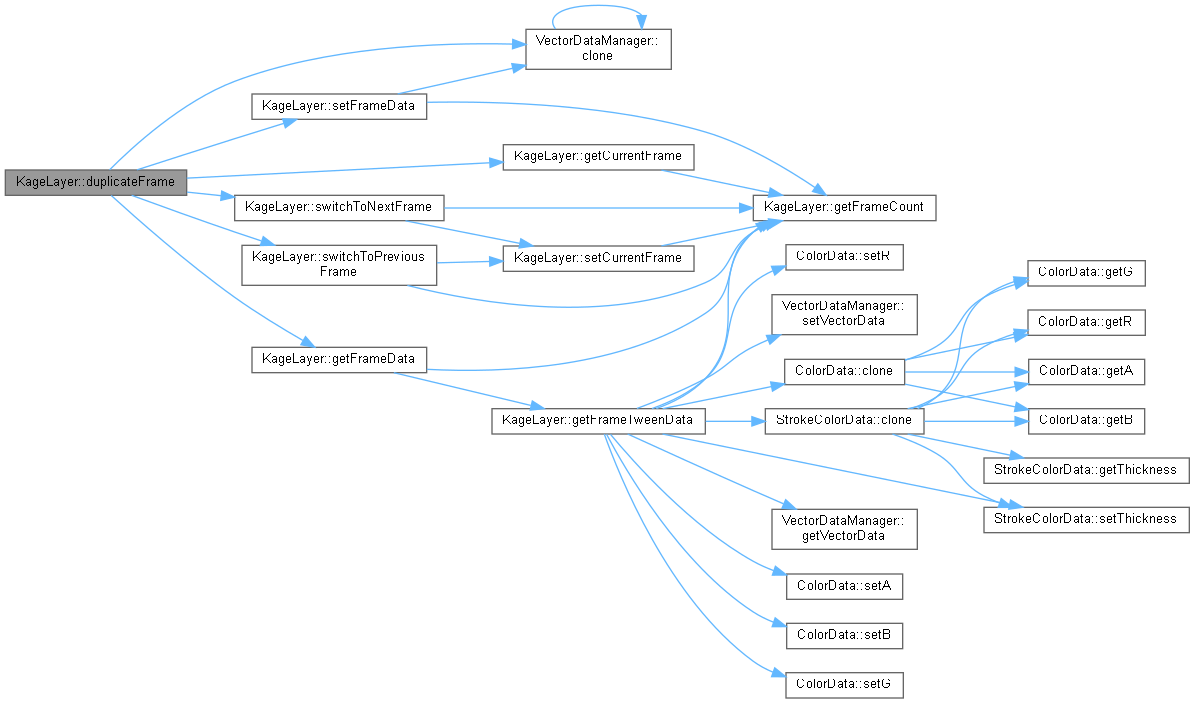
| std::vector< unsigned int > KageLayer::duplicateShapes | ( | std::vector< unsigned int > | p_selectedShapes | ) |

| void KageLayer::extendFrame | ( | ) |

| bool KageLayer::flipHorizontalSelectedShape | ( | std::vector< unsigned int > | p_selectedShapes | ) |

| bool KageLayer::flipVerticalSelectedShape | ( | std::vector< unsigned int > | p_selectedShapes | ) |


| bool KageLayer::forceSetTween | ( | unsigned int | p_tween | ) |

| unsigned int KageLayer::getActiveFrameID | ( | ) |
Will return which Frame is currently active for editing or viewing.
| unsigned int KageLayer::getCurrentFrame | ( | ) |

| KageFrame * KageLayer::getFrame | ( | ) |
| KageFrame * KageLayer::getFrameAt | ( | unsigned int | p_frame | ) |

| VectorDataManager KageLayer::getFrameData | ( | ) |
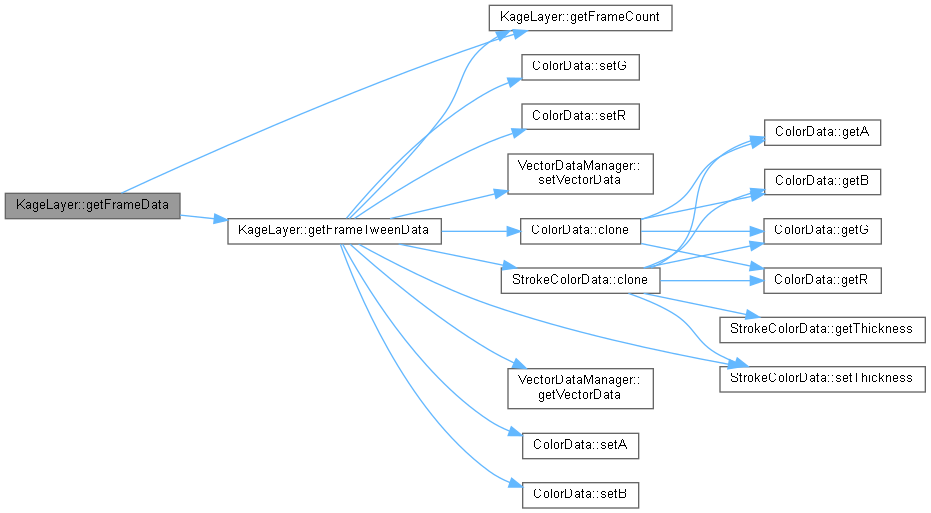

| VectorDataManager KageLayer::getFrameDataAt | ( | unsigned int | p_frame, |
| bool | p_frameOnion, | ||
| bool | p_layerOnion ) |
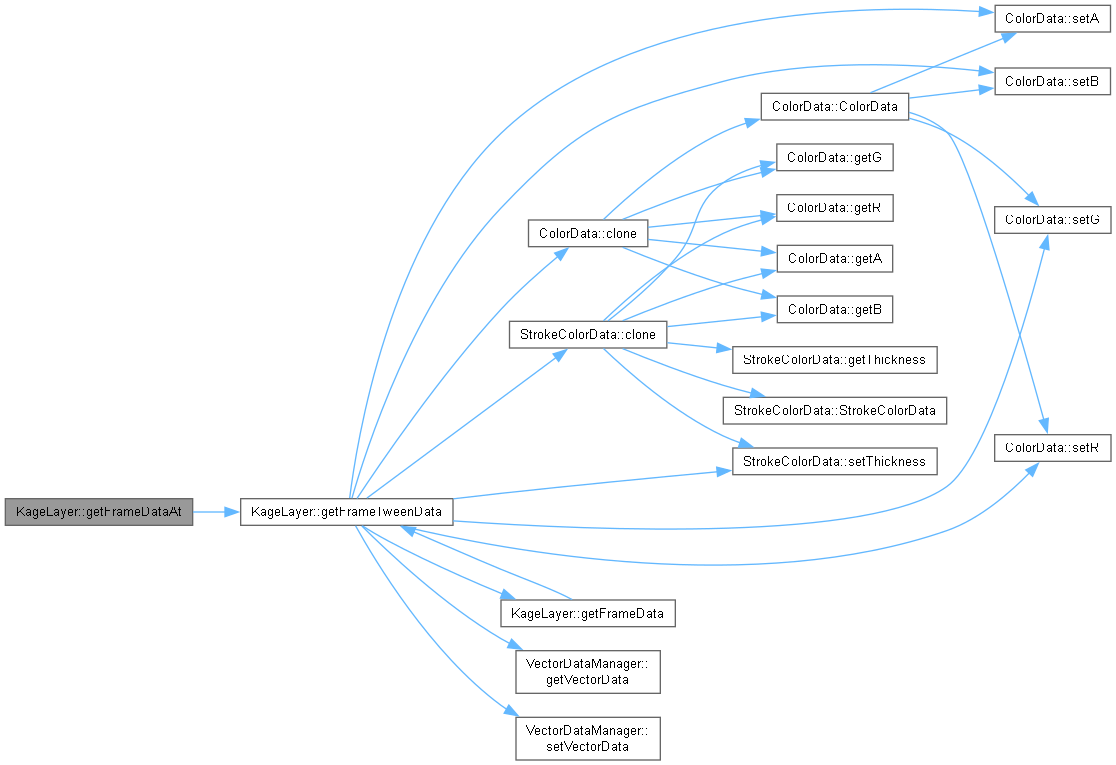

| unsigned int KageLayer::getFrameNumberByID | ( | unsigned int | p_frameID | ) |
| VectorDataManager KageLayer::getFrameTweenData | ( | unsigned int | p_frameIndex | ) |
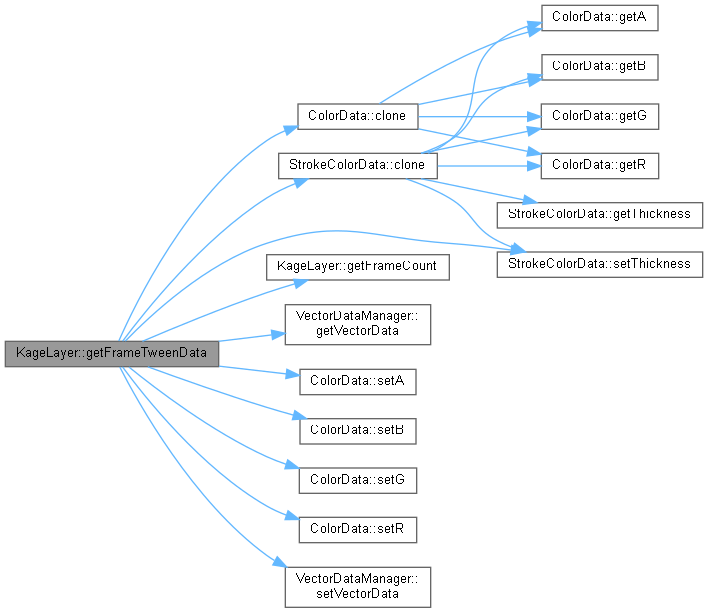

| unsigned int KageLayer::getID | ( | ) |
| std::string KageLayer::getLabel | ( | ) |

| VectorDataManager KageLayer::getPreviousFrameData | ( | unsigned int | p_frameID | ) |
NOTE: "Frame" – NOT "frame ID".
| KageScene * KageLayer::getScene | ( | ) |
| unsigned int KageLayer::getTween | ( | ) |

| std::vector< unsigned int > KageLayer::groupSelectedShapes | ( | std::vector< unsigned int > | p_selectedShapes | ) |

| bool KageLayer::isCurrentFrame | ( | unsigned int | p_frameID | ) |
| bool KageLayer::isLocked | ( | ) |

| bool KageLayer::isSelected | ( | ) |

| bool KageLayer::isVisible | ( | ) |

| std::vector< unsigned int > KageLayer::lowerSelectedShape | ( | std::vector< unsigned int > | p_selectedShapes | ) |

| std::vector< unsigned int > KageLayer::lowerToBottomSelectedShape | ( | std::vector< unsigned int > | p_selectedShapes | ) |

| bool KageLayer::moveToLeft | ( | ) |

| bool KageLayer::moveToLeftAt | ( | unsigned int | p_frame | ) |
Moves Current Frame to Left.

| bool KageLayer::moveToLeftMost | ( | ) |
Moves Current Frame to Left on indicated Frame.

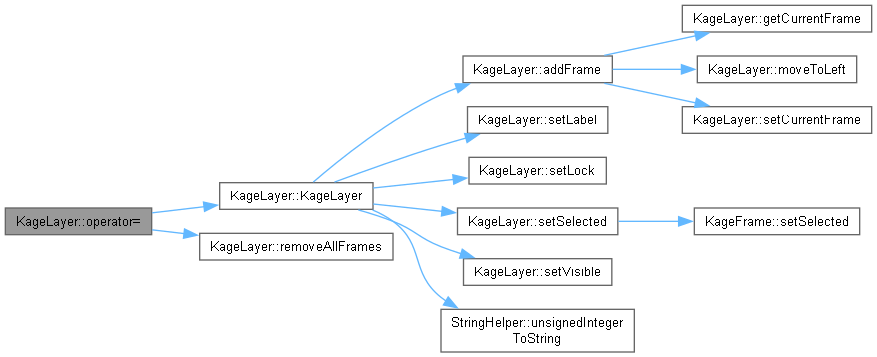
| std::vector< unsigned int > KageLayer::raiseSelectedShape | ( | std::vector< unsigned int > | p_selectedShapes | ) |

| std::vector< unsigned int > KageLayer::raiseToTopSelectedShape | ( | std::vector< unsigned int > | p_selectedShapes | ) |

| bool KageLayer::recenterRotationPoint | ( | std::vector< unsigned int > | p_selectedShapes | ) |

| bool KageLayer::removeAllFrames | ( | ) |

| bool KageLayer::removeFrame | ( | ) |
If KageFrame is NULL or Last Frame (but not Frame-index0), remove Frame Widget, else, do below steps.
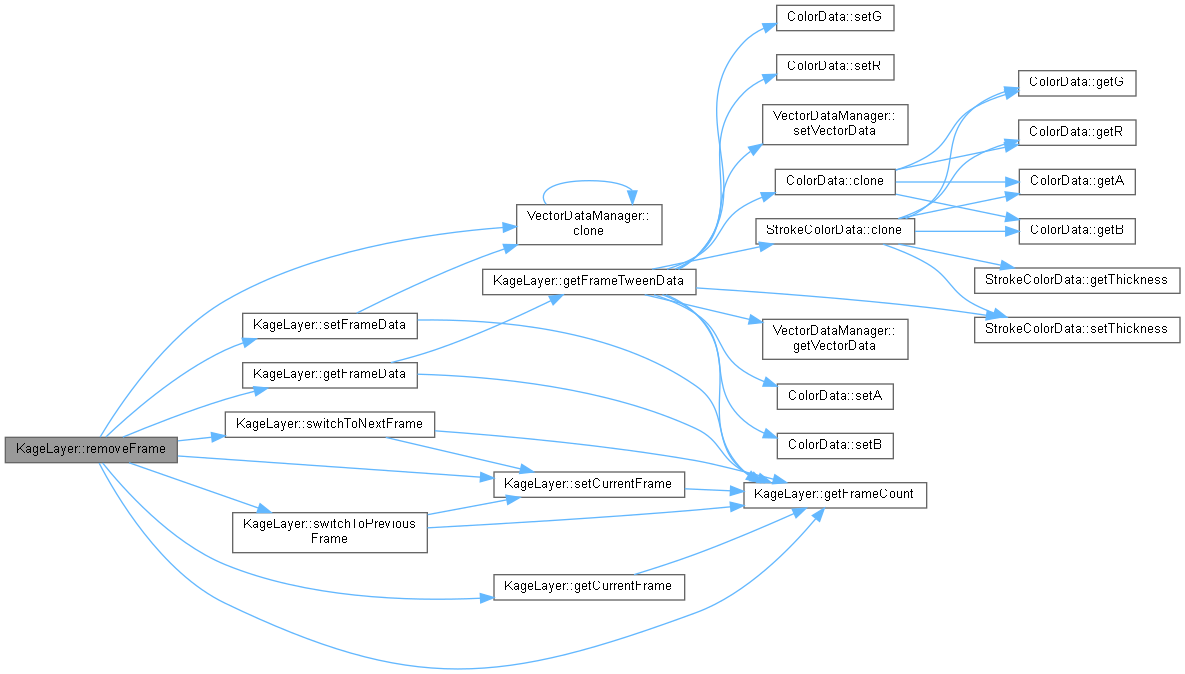
| bool KageLayer::selectAllFrame | ( | bool | p_selectAll | ) |
| void KageLayer::setCurrentFrame | ( | unsigned int | p_frame, |
| bool | p_addSelected ) |
For use of Kage. When a KageLayer is clicked, KageLayerManager will call this function via Kage then sets currently active Frame along Layer
| p_frame | is Frame Number known to KageFrame(/Layer?) |
| p_addSelected | add more selected Frame or not |
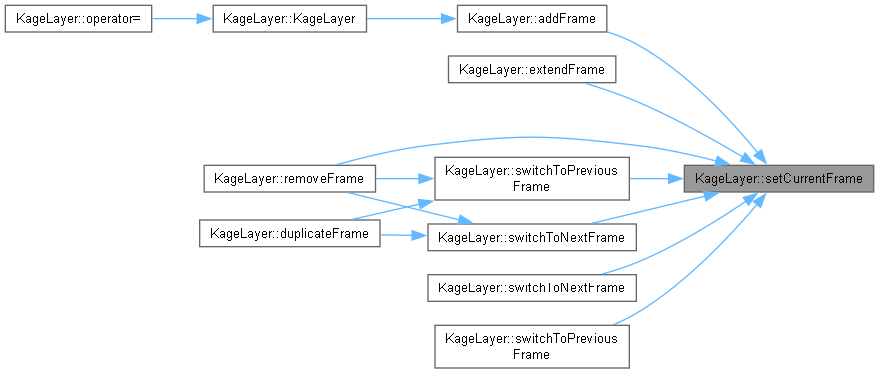
| void KageLayer::setCurrentFrameByID | ( | unsigned int | p_frameID | ) |
| bool KageLayer::setExtendedFrameTween | ( | unsigned int | p_frameID, |
| unsigned int | p_tween ) |
| bool KageLayer::setFrameData | ( | VectorDataManager | p_vectorsData | ) |


| bool KageLayer::setFrameDataToPreviousFrame | ( | VectorDataManager | p_vectorsData, |
| unsigned int | p_frameID ) |
| void KageLayer::setFrameExtension | ( | KageFrame::extension | p_extension | ) |
| void KageLayer::setLabel | ( | std::string | p_label | ) |

| void KageLayer::setLock | ( | bool | p_lock | ) |

| bool KageLayer::setPreviousFrameTween | ( | unsigned int | p_frameID, |
| unsigned int | p_tween ) |
| void KageLayer::setSelected | ( | bool | p_selected | ) |
| void KageLayer::setSelected | ( | KageFrame * | p_frame | ) |
| bool KageLayer::setTween | ( | unsigned int | p_tween | ) |

| void KageLayer::setVisible | ( | bool | p_visible | ) |

| bool KageLayer::switchToNextFrame | ( | ) |
Called by KageFrame for navigating to Previous Frame.
index + 1 = becomes frameNumber for current. then +1 becomes frameNumber of Next Frame


| bool KageLayer::switchToNextFrame | ( | unsigned int | p_frameID | ) |
Called by FrameSet for navigating to Next Frame.
index + 1 = becomes frameNumber for current. then +1 becomes frameNumber of Next Frame

| bool KageLayer::switchToPreviousFrame | ( | ) |
index + 1 = becomes frameNumber for current. then -1 becomes frameNumber of Previous Frame; thus ‘setCurrentFrame(i)’


| bool KageLayer::switchToPreviousFrame | ( | unsigned int | p_frameID | ) |
Called by FrameSet for navigating to Previous Frame.
index + 1 = becomes frameNumber for current. then -1 becomes frameNumber of Previous Frame; thus ‘setCurrentFrame(i)’

| void KageLayer::toggleLock | ( | ) |

| void KageLayer::toggleVisibility | ( | ) |

| std::vector< unsigned int > KageLayer::ungroupSelectedShapes | ( | std::vector< unsigned int > | p_selectedShapes | ) |

| unsigned int KageLayer::_activeFrame |
Moves Current Frame to Left.
| unsigned int KageLayer::_currentFrameID |
| unsigned int KageLayer::_currentFrameIndex |
| KageFrame* KageLayer::_framePtr |
| std::string KageLayer::_label |
| bool KageLayer::_lock |
| KageScene* KageLayer::_scene |
| bool KageLayer::_selected |
| bool KageLayer::_visible |
| unsigned int KageLayer::frameCtr |
| std::vector<KageFrame*> KageLayer::Frames |
| unsigned int KageLayer::layerID |